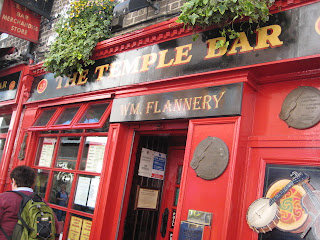Tuesday, May 3: We toured Dublin Castle inside and below. It has a long history, and was used mostly by the British during their rule of Ireland. In 1923, the Castle was given to the Irish. Most of it does not look like a castle, but nonetheless, it is called this. Once upon a time, there was an actual castle on this site, and there are some remnants of it, especially underground.
The Single Ladies room. The story is that the married gentlemen went into another room to do men things, and the married ladies went into another room to do what women do. The single ladies went to this room and lined the walls, waiting for the single men to ask them to dance. If they never got asked to dance, they just stood huddled together for hours until the carriages took everyone away---early the next morning!
Another view of the throne room.
Ceiling of the dining room.
One end of the dining room.
St. Patrick's Hall--this was the ceiling.
Work being done in St. Patrick's Hall, preparing for the inauguration of the new Irish President after the election in November.
The National Symbol of Ireland--The Harp--the only country in the world to have a musical instrument at its symbol.
In the courtyard of the Castle
Now we go underground. During the 1980s, when they were doing some renovation, they discovered another tower from the old Castle. This picture shows how the castle looked in about the 11th century.
Another rendition of the Castle and the town of Dublin within the walls.
The bottom of the newly discovered tower, called the Powder Tower, because gun powder was stored here.
Part of the old wall of Dublin Castle
And more wall......
Entries into the castle were small and few, in order to more easily defend them. This was an entry to the old Dublin Castle.
This is part of the old wall of Dublin city. At one time, there was an opening here, but had been closed in (at this point I could not hear the tour guide, so I don't know why it was closed in). There is a little water here, what is left of the area that gave Dublin its name. The river "Poddle" joined the river "Liffey", and at that spot, formed a "black pool," or dubh linn in Gaelic. The river Liffey was diverted and remains, but Poddle is gone.
If you look closely at the top half of this drawing, slightly to the left and center, you'll see the opening in the wall before it was closed in.
After our tour of the Castle, we went down to Temple Bar for lunch. This time we actually ate at The Temple Bar. We had some great sandwiches, Guinness, and a little live music as well.































Cool castle!!!!
ReplyDeletedenise